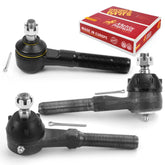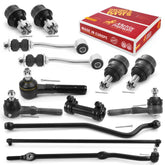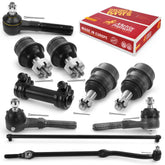Adjustable vs. Non-Adjustable Control Arms: A Technical Comparison
Adjustable vs. Non-Adjustable Control Arms: A Technical Comparison
When it comes to optimizing a vehicle's suspension system, control arms play a critical role. They connect the chassis to the wheel hub, allowing vertical movement while maintaining proper alignment and control. Control arms come in two main varieties: adjustable and non-adjustable. This technical blog will dive into the details and compare the characteristics, benefits, and considerations of adjustable and non-adjustable control arms.
Non-Adjustable Control Arms:
Non-adjustable control arms, or fixed control arms, are the standard option in most factory-installed suspension systems. They are designed to offer consistent performance and require minimal maintenance. Here are the key technical aspects of non-adjustable control arms:
- Design and Geometry: Non-adjustable control arms have a fixed length and geometry, which means they cannot be modified to alter suspension settings. The vehicle manufacturer determines the control arm's design to balance ride comfort, handling, and tire wear.
- Mounting Points: Non-adjustable control arms typically have fixed mounting points on the chassis and wheel hub, allowing them to pivot within their specified range of motion. These mounting points are designed to maintain the optimal suspension geometry set by the manufacturer.
- Ease of Installation: Due to their fixed nature, non-adjustable control arms are relatively easy to install since there is no need for additional adjustments or alignment procedures. They can be replaced with compatible OEM (Original Equipment Manufacturer) parts or aftermarket options designed to match the vehicle's specifications.
- Cost-Effectiveness: Non-adjustable control arms are generally more affordable than their adjustable counterparts. Non-adjustable control arms are a practical choice if you're looking for a cost-effective solution and don't require specific suspension adjustments.
- Limited Customization: Non-adjustable control arms restrict customization options, challenging fine-tuning suspension settings according to individual preferences or specific vehicle modifications. Any adjustments to the suspension would typically require additional aftermarket components or modifications to other suspension components.
Adjustable Control Arms:
Adjustable control arms provide greater flexibility and control over a vehicle's suspension system. They offer the ability to modify suspension settings to accommodate various factors, such as vehicle height, alignment, and performance upgrades. Consider the following technical aspects of adjustable control arms:
- Versatility and Customization: Adjustable control arms feature multiple mounting points or threaded ends, allowing for changes in their length or angle. This adjustability enables precise control over suspension settings, including camber, caster, and toe-in/toe-out. You can fine-tune the suspension geometry by altering the control arm's length to meet specific requirements.
- Alignment Adjustments: Adjustable control arms are beneficial when correcting wheel alignment issues. If your vehicle experiences uneven tire wear, pulling to one side, or poor handling due to misalignment, adjustable control arms allow precise adjustments to bring the suspension back into alignment.
- Performance Optimization: Adjusting the suspension settings with adjustable control arms can improve handling, better cornering, and increased traction. This is particularly beneficial for off-road enthusiasts, track racers, or those with modified vehicles. Fine-tuning the suspension geometry can optimize the vehicle's performance based on specific driving conditions or modifications.
- Higher Cost and Complexity: Adjustable control arms' additional features and adjustability result in a higher price than non-adjustable control arms. Moreover, installation and setup may require more time, expertise, and alignment procedures to ensure proper adjustments and alignment of the suspension system.
- Aftermarket Options: Adjustable control arms are often available as aftermarket upgrades, allowing vehicle owners to replace their non-adjustable control arms with adjustable ones. These aftermarket options come in various designs and materials, offering different levels of adjustability and performance enhancements.
Making the Right Choice:
When deciding between adjustable and non-adjustable control arms, it's essential to consider the following technical factors:
- Vehicle Usage: Non-adjustable control arms are generally suitable for commuting and street driving. They provide reliable performance and require minimal maintenance. However, if you engage in spirited driving or off-roading or have a modified vehicle, adjustable control arms offer the versatility to fine-tune the suspension settings for optimal performance.
- Alignment Issues: If your vehicle frequently experiences alignment-related problems, adjustable control arms can be a valuable solution. Their adjustability allows for precise corrections, ensuring proper alignment, improved handling, and extended tire life.
- Modification Level: If you have modified your vehicle or plan to do so in the future, adjustable control arms provide the flexibility to accommodate those modifications effectively. They allow you to optimize the suspension geometry to complement the modifications and extract the maximum performance from your vehicle.
- Budget: Adjustable control arms come at a higher cost due to their added features and adjustability. Consider your budget and weigh it against the benefits you expect from the adjustable control arms. If needed, it's crucial to factor in the potential cost of professional installation and alignment procedures.
Choosing between adjustable and non-adjustable control arms requires careful consideration of your specific needs and preferences. Non-adjustable control arms are reliable and cost-effective for most everyday driving situations, while adjustable control arms offer flexibility, customization, and performance optimization. By understanding the technical differences and considering factors like vehicle usage, alignment issues, modification level, and budget, you can make an informed decision and select the control arms that best suit your requirements.
At Metrix Premium, we offer a comprehensive range of control arms, including adjustable and non-adjustable options. Our adjustable control arms provide flexibility, customization, and performance optimization, making them suitable for enthusiasts, off-road enthusiasts, and those with modified vehicles. On the other hand, our non-adjustable control arms offer reliability, ease of installation, and cost-effectiveness for everyday driving situations. Depending on your specific needs, vehicle usage, and budget, Metrix Premium has control arms to meet your requirements and provide the desired suspension performance. Check out our catalog for more information on our premium control arm selections.









